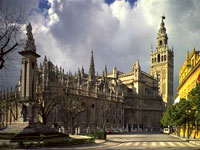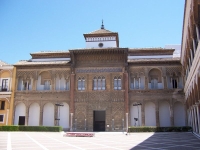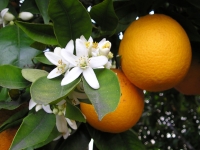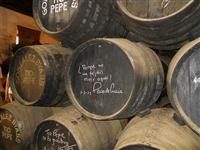Seville Travel Guide
Elegant, sun-soaked and unforgettably spirited, Spain's great southern city of Seville has a rich history that shows through exquisite Moorish architecture and opulent 16th century Spanish buildings. The destination is the perfect setting for high culture and romantic operas such as Carmen, Don Juan and Figaro; flamenco, tapas and bull fighting are other standouts on its incredible list of attractions.
The soul of the city is best epitomised during its two passion-filled grand festivals: the Semana Santa (Holy Week), held the week before Easter, and the Feria de Abril de Sevilla (Seville April Fair), which takes place two weeks after Easter Sunday. Dating back to at least the 16th century, the Semana Santa is notable for its spectacular processions, which gather thousands of locals and visitors. Semana Santa celebrations are famous for their Baroque statues of the Virgin Mary, which sport silver and gold crowns, embroidered cloaks and velvet tunics that only reveal their face and hands.
The Feria de Abril was first celebrated in the mid 18th century and has evolved from being a livestock and agricultural fair to being a purely Sevillian tradition. Over 1000 striped, intimately-decorated casetas (tents) line both sides of the streets, and offer festival goers wine, delicious tapas and lively songs called sevillanas. Adorned horse-drawn carriages, women in bright, polka-dotted flamenco dresses, and men on horseback and in traditional farm-worker clothes complete the festive atmosphere.
Seville has an impressive collection of historical sites, including its cathedral, which is one of the largest Gothic buildings in the world. Having been occupied by the Moors for 500 years, the city also has a legacy left by the Arab kings in the form of the Alcazar. This palace-fortress is regarded as one of the finest surviving examples of Moorish architecture.
Seville is the regional capital of Andalusia, which contains the densely populated beach resorts of the Costa del Sol along its southern reaches, and the mountain villages of the Sierra Nevada range further inland, about 25 miles (40km) from the coast. These are among the many charms that draw visitors back, time and time again.
Things to do in Seville
Wandering the narrow maze of Santa Cruz, Seville's most romantic neighbourhood, and admiring its balconies, flowers and stately mansions is one of the best tourist experiences in Spain. This adventureland can occupy visitors for days, but also offers rest through its courtyard cafes, bars and restaurants whenever its charming labyrinth of narrow streets becomes overwhelming. Seville is a city best explored on foot, and Santa Cruz is one of the districts where tourists can tap into the soul of this special Spanish destination.
Other famous Seville attractions include the enormous Seville Cathedral, which is one of the biggest Gothic churches in the world; the recently renovated Plaza de Espana (the stately square was constructed in 1929); and the Maria Luisa Park, which is one of the loveliest green lungs in Europe. However, the city's most famous attraction is the UNESCO-listed Alcazar of Seville, an ancient palace complex considered one of Spain's great treasures. Visitors to Seville should also be sure to take in a cultural performance as the city is alive with authentic Spanish music and Flamenco.
Additionally, there are several wonderful performing arts venues, including the Casa de la Memoria de Al-Andalus and La Casa del Flamenco Auditorio Alcantara. Good museums in Seville include the Museo Provincial de Bellas Artes de Sevilla (Museum of Fine Arts).

Seville Cathedral
Seville Cathedral is one of the largest churches in the world, and its massive Gothic edifice took more than a century to build. Its story began with group of religious fanatics who, in 1401, decided to build a church so wonderful that 'those who come after us will take us for madmen'. The cathedral was built on the site of the Almohad Mosque, which was demolished to make way for its construction. Known as La Giralda, the mosque was originally built in 1198, of which only a minaret remains. Today it's open to tourists. Along with the Alcazar and the Archivo de Indias, the cathedral has been declared a UNESCO World Heritage Site and is undoubtedly one of the highlights of a visit to Seville.

Alcazar of Seville
Alcazar is Seville's top attraction and one of the most famous in Spain. The complex is a UNESCO World Heritage Site and an undisputed architectural masterpiece. The site of Seville's Moorish palace has been occupied by the city's rulers since Roman times, and has been a favoured residence of Spanish kings since the Middle Ages. Established by the Moors as early as the 7th century, it was primarily built in the 1300s and has been added to and altered by successive occupants ever since. Of the early Christian additions, most notable is the colonnaded quadrangle of the Patio of the Maids. The palace is set in beautiful, extensive gardens where it is possible to picnic.

Santa Cruz
A former Jewish ghetto, Santa Cruz in Seville is an enchanting maze of alleys, gateways, and courtyards. Every street corner has a romantic legend attached to it, and windowsills are festooned with flowers and the fragrance of jasmine pervades the air. Santa Cruz is also bordered by the Alcazar, the Jardines de Murillo, and Santa Maria La Blanca, and can be reached via the Calle Rodrigo Caro. Some of the sights to look for are the Hospital de los Venerables, which contains Sevillian artworks; the beautiful mansions in the Calle Lope de Rueda; and the Convent de San Jose, which boasts relics of Saint Teresa of Avila; and the Iglesia de Santa Maria la Blanca, which features Murillo's 'Last Supper'.

Museo Provincial de Bellas Artes de Sevilla
This restored convent dates back to 1612 and houses one of Spain's most important and largest art collections. Hidden in a tiny plaza off Calle de Alfonso XII in Seville, the museum was established in 1839, and contains art spanning from medieval times to the 20th century, with the pride of the collection being the range of paintings from the 17th century, which was Seville's Golden Age. Highlights include the religious paintings of Seville's own Esteban Murillo, but the collection also includes other Seville School artists such as the macabre works of Juan de Vales Leal and Francisco de Zurbaran. There are also two paintings by El Greco, a Greek artist whose emotional style thoroughly captured the passion of Counter-Reformation Spain.

Maria Luisa Park
Regarded as one of the loveliest parks in Europe, this half-mile area in southern Seville lies near the port and is planted with palms, orange trees, elms, and Mediterranean pines. Bright and beautiful flower beds vie for the eye with hidden bowers, ponds, pavilions, water features, and statues in this little paradise, which was designed in the 1920s and thus reflects a mix of Art Deco and Mudejar styling. The park was originally part of Seville's World Expo, which brought a burst of creative architecture and rejuvenation during the 1920s, and which included the redirection of the Guadalquivir River and the construction of some opulent buildings, such as the stylish Guatemala building off the Paseo de la Palmera.

Sherry Bodegas
Andalusia's chalky soil is ideal for the cultivation of the palomino grape, from which the world-famous sherry (jerez) of the region is made. The main sites of sherry production in Andalusia are Jerez de la Frontera and Montilla, and these charming towns are home to plenty of self-proclaimed sherry connoisseurs, who will debate the quality of the sweet amber-coloured blends with the seriousness usually reserved for appraising the finest French wines. An increasingly popular tourist activity for visitors to southern Spain is to tour the bodegas of the region, wineries with a history dating back to Roman times, which specialise in the fermentation of palomino grapes and the production of sherry.
Eating Out
Eating out in Seville is approached with the same laid-back simplicity that characterises the city's approach to life in general. Local cuisine ranges from honest, uncomplicated traditional dishes to inventive new tastes; foodies will find mouth-wateringly delicious surprises around every corner.
Like the architectural and historical roots of the Andalusian region, cuisine in Seville is a blend of Mediterranean and Moorish traditions. Main ingredients include olive oil, garlic and wine, but a strong Muslim influence has infused recipes with a bit of mint, a pinch of spice or fragrant citrus, and almond elements.
Many visitors are surprised to learn that the city lays claim to Spain's most well-known culinary legacy: tapas. These small, bite-sized portions make for light and delicious meals and cater perfectly to a culture that believes whole-heartedly in the value of good conversation. Some regional favourites include jamón Iberico de bellota (acorn-fed Iberian ham), espinacas con garbanzos (spinach with chickpeas), cazón en adobo (fried dog fish) and carrillada de cerdo (pork cheeks).
Though tapas used to be complimentary alongside a nip of sherry or a glass of wine, these days visitors will be hard-pressed to find a restaurant simply 'giving away' the traditional side of jamon (cured ham) or the odd bowl of acietunas (olives). Still, sampling one of the 4,000 odd tapas bars in Seville is a must.
Visitors can also dine at traditional abacerías (tiny grocery stores that often serve gourmet products such as wine, cheese and charcuterie); restaurants that serve regional classics such as the flavourful rabo de toro (bull's tail stew) and cochinillo asado (roast suckling pig); or establishments that create some of Spain's most modern, artistically-heightened dishes.
Travellers should ask about the menu del dia (menu of the day) over lunchtime; this normally includes a choice of soup or salad, a main course and a dessert, and often proves a delicious and economic way to move through Seville. Foreigners should bear in mind that the Spanish eat late, and that most restaurants only open at 8pm. Locals will filter in between 9pm and 11pm.
Shopping
Seville has everything from small, speciality shops to big, overbearing department stores. The area around Plaza Neuve is prime territory for anything chic and stylish, and the pedestrian thoroughfares of Calle Tetuan and Calle de las Sierpes are cluttered with opportunities to purchase some smart Spanish clothes or pay top dollar for haute couture.
Tourists shopping in Seville may also be interested in scooping up a few items more aptly aligned with local culture. Ceramics and Andalusian linen and shawls make great Seville souvenirs and are in no short supply. Visitors can take a trip across the Guadalquivir River to the traditional tile-making area of Triana; a handful of shops and functioning workshops sell beautifully crafted tiles and in some cases it's possible to watch the craftsman shape their wares. Many of the beautiful azulejos (ceramic tiles) adorning local churches, houses and tapas bars are still sculpted there today. If visitors don't feel like trooping so far, the area around the Reales Alcazares and the Barrio Santa Cruz also houses a healthy supply of shops selling hand-painted ceramics and embroidered blankets and scarves.
Most shops in Seville are open from 10am to 2pm and then from 5pm to 8pm during the week; from 10am to 2pm on Saturday; and are closed on Sundays. The larger stores often stay open all day. Most places accept all major credit cards.
Nightlife
Seville may be pegged as the slightly sleepy southern cousin of Madrid and Barcelona, but there is still a decent local nightlife. Between the bohemian tastes of the university students and the affinity for the arts held by the more sophisticated Sevillianos, there is a wide assortment of Andalusian activities after dark.
A great way to start an evening is by blazing a tapas trail. A wide selection of dingy dives and smoother, more stylish spaces crowd around the cobblestone streets of Barrio Santa Cruz and the area around the Catedral de Seville. Travellers should simply look for the iconic leg of jamon (cured ham) hanging from the ceiling and pop in for a quick bite, an easy chat and a cold Cruzcampo (Seville's local beer).
When visitors can't stomach any more sample-sized portions, they can head to either Plaza Alfalfa or Calle Betis for a bit of bar-hopping. During Seville's sultry summer nights, sipping a sherry alongside the Guadalquivir River is also an intoxicating way to kick-off the evening.
Most Seviallanos only leave home around 11.30pm, at which point they start the night with a stiff drink and a shot. Partygoers drain their drinks and head to the nightclubs around 1am, where it's possible to party until 10am the next morning.
For those with a calmer, more cultural appetite, the nightlife in Seville can be just as satiating. Flamenco, a passionate mix of dance, music and singing with roots reaching into Andalusia's Roma (gypsy) communities, is a firm favourite and must-see in the city. There are plenty of venues with regular tablao (performances); the Triana district caters to locals while options in Santa Cruz are more tourist-friendly, often offering a traditional Andalusian meal alongside the performance. Seville's opera house, Teatro de la Maestranza, attracts iconic celebrities and features big-name shows; occasionally jazz and classical concerts also take place.
Getting Around
Most of the tourist sights in Seville are in the central area, which is flat and best explored on foot. Those travelling further afield will find buses the easiest and most economical way of getting around. Bus stops are easy to find on the main avenues and run on circular routes around the city, and line routes in all directions out of it. Bus routes emanate from Plaza Nueva, Plaza de la Encarnacion, La Barqueta, and Prado de San Sebastian.
Taxis can be found at designated stands in all the main plazas, or can be hailed on the street if showing a green light, which means they are available. Tourists should always ensure that the meters in taxis are operational and that they are only turned on at the beginning of their trip as foreigners are sometimes the victims of overcharging. Uber and Lyft are options as well.
As with all Spanish cities, it's best to avoid driving in Seville as the roads are confusing and hard to negotiate. Spanish drivers are notorious for their casual and chaotic approach to rules of the road, and although rented cars are wonderful for excursions out of Seville, they are best kept parked at the hotel while sightseeing in the city. Those exploring the city on foot should be sure to get a map when wandering around neighbourhoods such as Santa Cruz, as the narrow maze of streets can be rather confusing.
Seville Climate and Weather
Seville has a mild Mediterranean climate, with warm, sunny summers and cool, mild, winters. The hottest months are July and August, when temperatures sometimes reach a high of 99ºF (37ºC). Temperatures are, however, sometimes modified by cool sea breezes, which is a relief at the height of summer.
Winter tends to have mixed sun and cloud, and January is the coldest month. Autumn and winter are the wettest seasons, and September and October often bring heavy showers or thunderstorms. March, which is early spring, can also be a wet month, but showers are usually followed by sunny periods. Seville receives hardly any rain during the hot summer months.
As with most of Spain, the height of summer, between June and August, is when most people choose to travel to Seville for the hot sunshine, tempered by cool sea breezes. Some argue that the best time to holiday in the city is spring, when temperatures are moderate and the crowds are thinner.
With its Mediterranean climate, however, Seville is a destination for all seasons, so long as visitors don't mind a few wet days during winter. Easter is a great time to go if visitors are looking for festivity, as Holy Week brings all sorts of fiestas to the city streets.
Spain travel info
Electricity
The electrical current is 230 volts, 50Hz. European-style two-pin plugs are standard.
Language
Spanish is the official language, but English is widely understood in areas frequented by tourists. Catalan, Galician and Basque are spoken in the relevant areas.
Money
Spain's official currency is the euro (EUR), which is divided into 100 cents. Money can be exchanged at bureaux de change and major hotels, but banks give the best rates. All major credit cards are widely accepted at most hotels, restaurants, and shops. ATMs are widespread and are generally the cheapest and most convenient method of obtaining money.
Tipping
Hotel and restaurant bills usually include service charges, but additional tips are welcomed for services rendered. In established restaurants, tips of about 10 percent are expected. Drivers of metered taxis expect small tips and it's customary to tip about 5 to 10 percent for most services, including guides.
Health
There are no health risks associated with travel to Spain, and no vaccination certificates are required for entry. Medical facilities are good but comprehensive travel insurance is always advised. Spain has a reciprocal health agreement with most EU countries that provides emergency health care for EU travellers on the same terms as Spanish nationals. After Brexit, the Global Health Insurance Card (GHIC) replaced the European Health Insurance Card (EHIC) for UK citizens. The GHIC allows UK citizens access to state healthcare during visits to the EU. The GHIC is not valid in Norway, Iceland, Liechtenstein or Switzerland, nor is it an alternative to travel insurance. EU travellers should take a European Health Insurance Card (EHIC). Travellers should take any medication they require along with them, in its original packaging and accompanied by a signed and dated letter from a doctor detailing what it is and why it is needed.
Safety
Most visits to Spain are trouble-free except for occasional street crime. Petty crime, such as pickpocketing and purse snatching, is most common in larger cities, particularly during holidays, festivals and weekends, and especially on public transport and in tourist areas. Thieves may work alone or in groups; visitors should be wary of strangers who offer or ask for help of any kind, or inform them of a stain on their clothes, as these are often ways of providing a distraction for accomplices. There are also scams involving letters for outstanding traffic fines or Spanish lottery winnings. Travellers can avoid incidents if they exercise all the normal precautions.
Local customs
Smoking in public places is banned and stiff fines will be imposed for smoking in areas such as enclosed public spaces, areas where food is prepared and sold, public transport, non-smoking areas of bars and restaurants, and any places that cater for children. Drinking alcohol in the streets of Madrid and the streets of the Canary and Balearic Islands is illegal.
Doing business
The business culture in Spain is slowly shifting but, for now, it's entrenched in tradition and it can take some time for foreigners to gain a foothold in the Spanish working world. It's important never to undermine authority as hierarchy is central to Spain's business world. Managers tend to make decisions without considering input from their colleagues.
A strong emphasis is placed on social status, character attributes, and personal pride. Success is often hinged upon being well-dressed, honourable, and dignified, while also exhibiting great social skills. Business meetings are generally conducted face-to-face and can go on for long periods, as Spaniards prefer long deliberations in order to avoid uncertainty in corporate dealings. Business meetings in Spain tend to tread a fine line between personal and formal.
Conducting business in Spain can entail navigation through a lot of red tape and bureaucracy. Spanish is the language of business, but some of the larger multinationals conduct meetings in both English and Spanish. Business hours are often quite varied, but generally open by 9am and close in the mid-evening with a two-hour lunch break during the early afternoon.
Business attire is quite conservative with men wearing dark or linen suits, shirts and silk ties. Women should wear modest dresses or tailored suits. Brand names or labels attract affirmation from colleagues and associates.
After the conclusion of successful negotiations, gifts are appropriate. Gifts should be of high quality and, when receiving a gift, it should be opened in front of the giver. Business cards are important and should be bilingual. Meetings are best scheduled for mid-morning, and establishing a formal yet personable environment is important before beginning. Meetings often occur over lunches and dinners.
Duty free
Travellers from EU countries are allowed the following items duty free: 800 cigarettes or 400 cigarillos or 200 cigars or 1kg tobacco; 110 litres beer; 90 litres wine; and 10 litres spirit. Travellers from non-EU countries may have 200 cigarettes or 100 cigarillos or 50 cigars or 250g tobacco; 1 litre spirits, 4 litres wine, and 16 litres beer.
Communications
The international access code for Spain is +34. WiFi is widely available; travellers can purchase local SIM cards for unlocked phones or use eSIMs if their cellular providers support it on their networks.
Passport & Visa
The borderless region known as the Schengen area includes the following countries: Austria, Belgium, Czech Republic, Denmark, Estonia, Finland, France, Germany, Greece, Hungary, Iceland, Italy, Latvia, Lithuania, Luxembourg, Malta, The Netherlands, Norway, Poland, Portugal, Slovakia, Slovenia, Spain, and Sweden. All these countries issue a standard Schengen visa that has a multiple entry option, allowing the holder to travel freely within the borders of all. Non-EU nationals must hold a return or onward ticket, all necessary documents for onward travel and sufficient funds. It is highly recommended that passports have at least six months' validity remaining after the intended date of departure from Spain. Immigration officials often apply different rules to those stated by travel agents and official sources.
Entry requirements
United States citizens require a passport valid for three months beyond the period of intended stay. No visa is required for stays of up to 90 days within a 180 day period.
British citizens require a passport valid for three months beyond the period of intended stay. No visa is required for stays of up to 90 days within a 180 day period.
Canadian citizens require a passport valid for at least three months beyond period of intended stay. No visa is required for stays of up to 90 days within a 180 day period.
Australian citizens require a passport valid for at least three months beyond period of intended stay. No visa is required for stays of up to 90 days within a 180 day period.
South African citizens require a passport valid for at least three months beyond period of intended stay. A visa is required.
Irish nationals require a valid passport, but a visa is not necessary.
New Zealand citizens require a passport valid for at least three months beyond period of intended stay. No visa is required for stays of up to 90 days within a 180 day period.
Useful contacts
Spanish Tourist Office, Madrid: www.spain.info.
112 (General).


